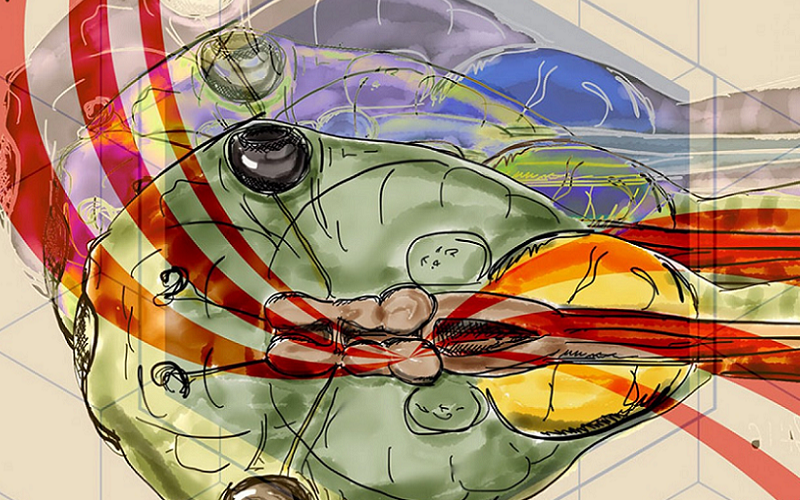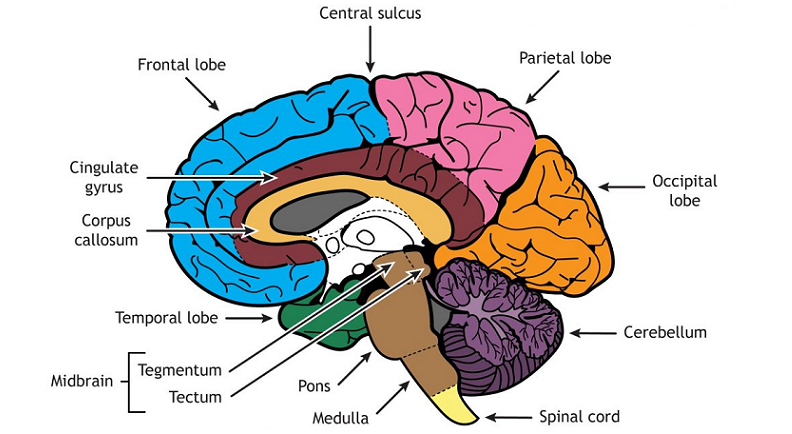
Nestled deep within the midbrain, the tectum is a masterful coordinator of sensory information and spatial awareness. Understanding this enigmatic structure offers us invaluable insights into how our brain processes the world around us, from interpreting what we see and hear to guiding our movements in space.
Contents
Introduction to the Tectum
The term “tectum” comes from the Latin word for “roof,” which aptly describes its position at the dorsal (top) part of the midbrain. The tectum primarily functions as a relay center for certain sensory information, and it plays a pivotal role in spatial orientation and reactive movements.
While the tectum might not garner as much attention as other brain structures like the cortex or hippocampus, it plays a vital role in our cognitive and sensory processing. For a part of the brain that has been relatively under-studied, its significance is anything but small. Its placement and functions make it a hub that bridges perception and action, thereby playing an essential role in our daily interactions with the world.
Understanding the tectum is not just an academic exercise. It holds real-world implications for cognitive health. Problems in this region can manifest in a range of disorders, from sensory processing issues to spatial orientation difficulties. This blog post aims to not only educate but also provide a foundation for those interested in cognitive health, whether you are a healthcare professional, a student, or just someone fascinated by how our brains work.
Historical Background of the Tectum
As we embark on this exploration of the tectum, it’s essential to take a moment to appreciate the historical context that has shaped our understanding of this brain region.
Early Discoveries
The history of understanding the tectum dates back to the late 19th and early 20th centuries, a period marked by significant advancements in neuroscience.
Pioneering Researchers
Some of the earliest research on the tectum came from neuroscientists who were exploring the functions of the midbrain. Researchers like Ramón y Cajal contributed to the foundational knowledge by detailing the cell types and architecture present in the tectal region. Their microscopic analyses paved the way for future studies to understand the functional aspects of the tectum better.
Initial Theories
Initially, theories about the tectum were largely based on lesion studies, where damage to the tectum resulted in specific sensory and motor impairments in animals. These studies suggested that the tectum was significantly involved in sensory processing and spatial orientation, a hypothesis that has been refined but not refuted by modern research.
Evolutionary Perspective
The story of the tectum isn’t limited to human anatomy; it’s a structure that has stood the test of evolutionary time. Understanding its roots in the animal kingdom gives us broader insights into its fundamental roles [1].
Presence in Other Animals
The tectum is not exclusive to humans. In fact, it is found in many vertebrates, from fish to mammals. In birds and reptiles, for instance, the tectum is quite developed and plays a central role in visual processing. This universality across species suggests that the tectum serves functions critical for survival.
Evolutionary Significance
From an evolutionary standpoint, the tectum has been preserved across various species due to its essential roles in processing sensory data and enabling spatial navigation—both critical functions for the survival of an organism. Its long evolutionary history speaks to its fundamental importance and helps researchers generate hypotheses about its diverse functions in humans.

Anatomical Location and Structure of the Tectum
Now that we have a grasp of the historical and evolutionary context surrounding the tectum, it’s time to focus our lenses on its anatomical features.
Position in the Brain
Before we dissect its individual components, it’s essential to place the tectum within the greater landscape of the brain. The tectum is situated in the midbrain, which is a part of the brainstem. It sits dorsal to (above) the cerebral aqueduct, making it a part of the roof of the midbrain—hence its name, “tectum,” which means “roof” in Latin.
Components
Now that we know where to find it let’s delve into the intricacies of its structural elements. The tectum comprises two major pairs of sub-structures, each serving specialized functions [2].
Superior Colliculi
The superior colliculi are the upper two “bumps” located in the tectum and are mainly concerned with visual processing. They help coordinate eye movements and even play a role in how we orient ourselves within our environment. The superior colliculi receive input from various visual pathways and interact with other brain regions to guide our visual focus.
Inferior Colliculi
The inferior colliculi, situated below the superior colliculi, handle auditory processing. They act as relay stations for auditory signals, forwarding this information to higher cortical regions where further processing occurs. If you’ve ever wondered how you instinctively turn your head toward the source of a sudden sound, you have your inferior colliculi to thank for that swift reaction.
Neural Connections
The functionality of the tectum isn’t isolated; it’s deeply embedded within a network of neural pathways that connect it to other brain regions.
The tectum receives sensory inputs from the eyes and ears and sends projections to regions like the thalamus and cerebral cortex. In turn, it receives feedback from these regions, creating a complex loop of information exchange that facilitates sensory processing and spatial orientation.

Functions of the Tectum
Now that we have explored the tectum’s location and anatomy, it’s time to understand what it actually does. What roles does this compact yet complex structure play in our perception and interaction with the world?
Overview of Main Functions
The tectum wears many hats when it comes to brain functions. At its core, it serves as a sorting and relay station for sensory data. While it isn’t responsible for the perception of sensory information—that’s the job of higher cortical areas—it plays a pivotal role in determining what happens to that data as it moves through the brain’s complex networks [3].
Sensory Processing
One of the tectum’s most studied roles is in the realm of sensory processing. It receives and forwards information related to our senses, particularly vision and hearing.
Visual Data
The superior colliculi are responsible for processing visual data. When light hits your eyes, the signal travels through various pathways to reach these upper “hills” of the tectum. From there, the data is forwarded to different parts of the brain responsible for perception, such as the visual cortex. Moreover, the superior colliculi help coordinate rapid eye movements, enabling you to focus on specific visual stimuli quickly.
Auditory Data
The inferior colliculi play a similar role but in the context of auditory data. When a sound wave hits your ear, the signal travels to these lower “hills” where it is processed and sent to areas like the auditory cortex. This function allows you to locate the source of a sound or react to auditory stimuli, like turning your head towards a sudden noise.
Spatial Awareness
Beyond its sensory roles, the tectum is also critical for spatial orientation. It helps you navigate the world around you by integrating sensory data into coordinated responses [4].
Orientation
The superior colliculi, in conjunction with other brain regions, help you orient your gaze and body position. If a bright flash occurs to your right, for instance, the superior colliculi contribute to the rapid turning of your head and eyes in that direction.
Motion Detection
Another intriguing function of the tectum is its role in detecting motion. Whether it’s recognizing the flight path of a thrown ball or sensing the movement of a predator, the tectum integrates various sensory inputs to facilitate swift and appropriate reactions.

Tectum Relationship with Other Brain Structures
Understanding the tectum in isolation provides only a partial picture. It’s crucial to consider how this structure interacts with other regions of the brain to collectively shape our sensory experiences, motor responses, and overall cognitive functions.
Sensory Pathways
The tectum plays an integral part in the complex web of sensory pathways that crisscross the brain. Its role as a relay and sorting station is made possible by its connections with several key sensory regions.
Visual Pathways
The superior colliculi are directly connected to the retina and are also involved in the broader visual pathway that includes the lateral geniculate nucleus of the thalamus and the visual cortex. These connections enable the superior colliculi to contribute to visual attention and eye movements [5].
Auditory Pathways
Similarly, the inferior colliculi have connections to the cochlear nuclei and are an essential part of the auditory pathway, which also involves the medial geniculate nucleus of the thalamus and the auditory cortex. This network of connections allows the tectum to play a role in sound localization and auditory reflexes.
Motor Systems
Beyond sensory pathways, the tectum is also connected to various motor systems, thereby influencing how we react to the world around us.
Interaction with the Basal Ganglia
The tectum communicates with the basal ganglia, a group of nuclei involved in motor control, to coordinate voluntary and involuntary movements. This relationship is particularly important when rapid reactions to sensory stimuli are required, such as quickly turning your head toward a sudden sound.
Connection to the Cerebellum
The tectum also has connections with the cerebellum, which plays a vital role in fine-tuning motor actions and balance. Through these interactions, the tectum contributes to the accuracy and fluidity of our movements in response to sensory inputs.
Higher Cognitive Centers
The tectum’s role doesn’t stop at basic sensory and motor functions; it also has intricate connections with higher cognitive centers, including the cerebral cortex.
Feedback Loops with the Cortex
The tectum shares feedback loops with various cortical areas, allowing for more complex processing and interpretation of sensory data. These connections facilitate attentional focus, decision-making, and even aspects of consciousness.
Interaction with the Limbic System
Interestingly, the tectum also communicates with parts of the limbic system, which is responsible for emotions and memory. While the exact implications of this are still under study, it hints at the tectum’s potential role in emotional reactions to sensory stimuli.
References
[1] The optic tectum controls visually guided adaptive plasticity
[2] Visual Instruction of the Neural Map of Auditory Space in the Developing Optic Tectum
[3] Topographically Localized Modulation of Tectal Cell Spatial Tuning
[4] Focusing on optic tectum circuitry through the lens of genetics
[5] Multisensory integration in the developing tectum is constrained by the balance of excitation and inhibition

